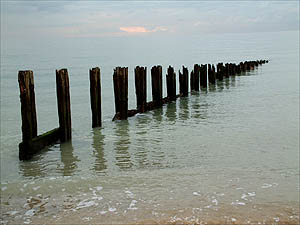Resilience and resistance

|
[Note by author: this article is in a very early stage of development; please do not cite it yet; MV, 12 march 2009]]. [Coastal and marine ecosystems are constantly changing and can respond to environmental disturbances both slowly or quickly. Resistance is the capacity of an ecosystem to remain relatively unchanged when confronted by a disturbance, while resilience has been defined in different ways: it can be a measure for the speed at which an ecosystem returns to its former state following a disturbance. It is also used in a way that more closely resembles the definition of ... (resistance) (cite Gunderson 2000[1] to avoid confusion)
Contents
Introduction
Coastal systems are naturally resilient. ... This article will discuss. In particular it will argue that ...Biodiversity allows ecosystems to adapt to changing conditions. Humans, however, have acted to increase the rate of change and consequently, it will be a great challenge for the marine environment to adapt rapidly enough in the future. These changes have been induced through pollution, fishing, sediment deposition and alteration of the global climate. Without genetic diversity, natural selection cannot occur and natural selection is limited, then adaptation is impossible. It is evident that the preservation of biodiversity and, more specifically, genetic diversity is of paramount importance for successful adaptation to our rapidly changing environments.
for Biodiversity: cite: Folke et al. 2004[2]
Resilience through re-colonization
To understand resilience of ecosystems it is essential to understand what drives succession within these ecosystems. Succession determines how, and how fast, communities return back to their original state, or perhaps enter a new state. many aspects of succession can be understood in terms of trade-offs between the ability to be either a good early (re-)colonizer, or a good competitor (r-species versus a K-species). Succession involves a gradual replacement of species that differ in these traits and that differ in the degree they tolerate, facilitate or inhibit certain environmental conditions and other species. ... see (Rossi et al. 2009[3])
We could thus also call a system resilient when it is organized in such a way that succession leads to a recovery of the original state.
Resilience and nutrient inputs
Cite Vos et al. 2005Cite error: Closing </ref> missing for <ref> tag).
Adaptation assisted by Man
Protecting sources, not sinks when creating Marine Protected Areas. Protecting sources of populations at all stages of succession, to preserve 'ecological memory' to the fullest possible extent. This includes protecting not only 'high quality' habitats that harbour healthy mature communities, but also 'low quality' and disturbed habitats that are required for those species that contribute to early recovery of perturbed areas (see Rossi et al. 2009[3]).
References
- ↑ Gunderson, L.H. 2000. Ecological Resilience - in Theory and Application. Annual Review of Ecolog and Systematics 31:425-439.
- ↑ Folke, C., Carpenter, S., Walker, B., Scheffer, M., Elmqvist, T., Gunderson, L. & Holling, C.S. 2004. Regime Shifts, Resilience, and Biodiversity in Ecosystem Management. Annual Review of Ecolog and Systematics 35:557-581.
- ↑ 3.0 3.1 ).Rossi, F., Vos, M. & Middelburg, J.J. 2009. Species identity, diversity and microbial carbon flow in reassembling macrobenthic communities. Oikos, Early View, (January issue).
DeAngelis, D. L. 1992. Dynamics of Nutrient Cycling and Food Webs. Chapman and Hall, London.
See Also
Resilience as a criterion in marine biological evaluation
Please note that others may also have edited the contents of this article.
|
